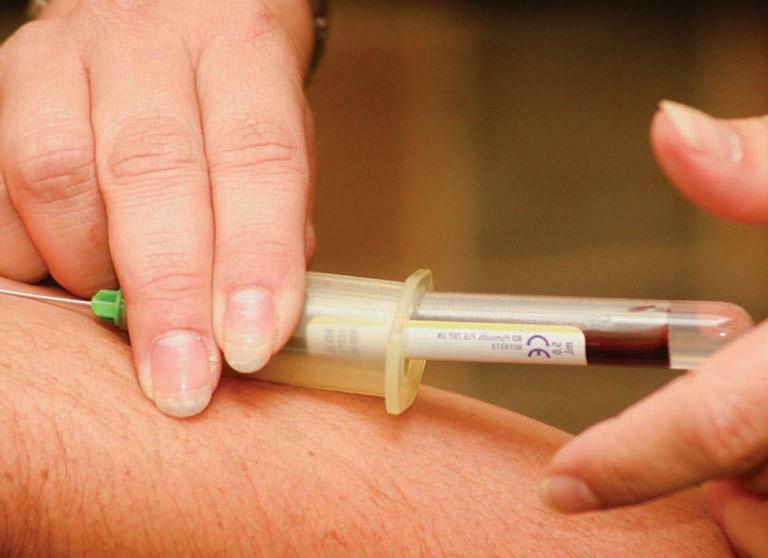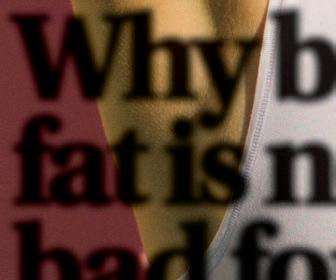
6 minute read
Health & Science

BODY FAT gets a bad press. One can scarcely travel anywhere on the Internet without coming across some sort of article telling you how to blast, burn, or banish it.
Advertisement
Body fat, or adipose tissue, lls a lot of integral roles: storing energy, generating heat, and regulating immune responses, among other functions. However, when fat cells become overloaded with excess nutrients, they become too big and don’t receive enough oxygen, causing them to die. is triggers a cascade of negative e ects that leads to hypertension, high blood sugar, and other metabolic conditions.
While commonly seen as an unsightly impediment, body fat, or adipose tissue, is actually integral to the proper functioning of the human body. Fat cells, called adipocytes, safely store excess nutrients as lipids, preventing these chemicals from aggregating in other tissues and clogging up the works, so to speak. For thousands of years, these lipid stores have served humanity as an on-demand energy source, built up in times of plenty and broken down for energy in times of scarcity. But passive energy storage isn’t all that body fat is good for.
“Adipose tissue regulates many aspects of whole-body physiology, including food intake, maintenance of energy levels, insulin sensitivity, body temperature, and immune responses,” a team of researchers from the University of Pennsylvania and the University of California-Los Angeles write in a new review paper published to the journal Cell. ese researchers, led by Claudio J. Villanueva at UCLA and Patrick Seale at Penn, argue that too much body fat isn’t actually what makes obese individuals unhealthy. e problem is that their fat tissue stops functioning normally. e problem isn’t body fat itself
Body fat is an essential organ, and a remarkable one at that.
Consider its unparalleled ability to expand and contract — no other organ can increase and decrease in size as body fat does. at’s because adipocytes can massively balloon as they suck up lipids like microscopic sponges, then de ate as they release them.
At the same time, fat tissue secretes hormones called adipokines that regulate metabolism, a ect satiety, and play a role in in ammation. ere are actually three types of body fat: white, brown, and beige. While white fat — the most common — is specialised solely for storage and hormonal function, beige and brown produce heat to keep us warm. Brown fat is stored in deposits whose locations are speci ed prior to birth (often around the collarbone and spine), while beige fat develops within stores of white fat. In fact, white fat cells actually convert to beige cells when environmental temperatures drop and revert back when temperatures rise. is ability highlights one of the hallmarks of body fat: like brain tissue, adipose tissue is incredibly “plastic” — that is, it changes and adapts depending upon the body’s needs. Unfortunately, as Villanueva, Seale, and their colleagues point out, this plasticity can take a big hit in individuals with obesity.
Citing a plethora of prior research, they suggest that some adipocytes can grow too large to receive enough oxygen from the available blood supply causing these cells to die. is, in turn, leads to a cascade of detrimental e ects: Dead fat cells cannot divide and create more cells, making it harder to store excess nutrients from food intake. Necrotizing adipocytes spill their own stored lipids, causing bodily havoc. In ammatory cytokines are excreted. “Consequently, adipose tissue becomes insulin resistant, in amed, and brotic, further compromising its function. All of these processes are continuous and mutually reinforcing, making it di cult to disentangle cause and e ect,” the authors write. is problem isn’t necessarily unique to individuals with obesity — even adipocytes in normal weight individuals can sometimes malfunction in this manner. But obese individuals do have more, often larger, fat cells, and thus more opportunities for their fat’s function to falter.
Estimates from the United States suggest that 23.5% of normal-weight adults are metabolically unhealthy while 31.7% of obese are metabolically healthy.
Metabolically unhealthy individuals often have high blood sugar, hypertension, and low HDL cholesterol, putting them at increased risk of stroke, heart failure, and a range of other diseases. e researchers suggest that drugs targeted to improve blood ow to fat cells could help resolve these issues.
“Many questions and opportunities for future discovery remain, which will yield new insights into adiposetissue biology and hopefully lead to improved therapies for human disease.”



A BLOOD test that can detect the early stages of the most common form of lung cancer is well on its way to being developed, according to scientists in China. In a new study, they’ve shown evidence that the test was over 90% accurate in identifying these tumours in samples taken from real life patients. More research, including clinical trials, will be needed before this test will be able to reach the public. e early detection of cancer is often crucial to ensuring patients their best chances of survival. While there are many screening tools available for many cancers, including blood tests, lung cancer patients aren’t always so fortunate. Currently, the only form of screening thought to have any value for lung cancer are yearly low-dose CT scans, but these are recommended solely for former or current smokers over the age of 50 who have a long history of smoking. ey’re also relatively costly and can have a high rate of false positives, which can lead to unnecessary invasive surgeries. ough lung cancer incidence and death rates have dropped over time, it remains one of the most common cancers worldwide. Creating a noninvasive test that can detect early lung cancer and be widely usable for screening high-risk groups is “urgently needed to improve the survival of lung cancer,” said study author Yuxin Yin, a researcher at the Peking University People’s Hospital. And he believes his team’s work can one day t that bill. e test is called the Lung Cancer Arti cial Intelligence Detector, or LCAID. In their new paper, published in the journal Science Translational Medicine, the team used the test on blood samples from more than 1,000 patients. Most of these samples came from patients who were already being screened for lung cancer through yearly CT scans, but some also came from patients who were undergoing thoracic (chest) surgery. Overall, the test was found to have a sensitivity of 90% and a speci city of 92% for detecting lung cancer, relative to standard diagnosis, with most cases being stage 1. A highly sensitive test provides relatively few false negatives, while a highly speci c test has fewer false positives. And though smoking is a major risk factor for this form of lung cancer, it can a ect nonsmokers as well, so the test could be useful for those who don’t smoke but may have a family history of lung cancer or other risk factors.









